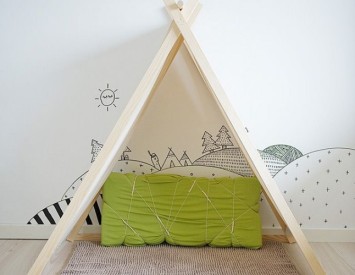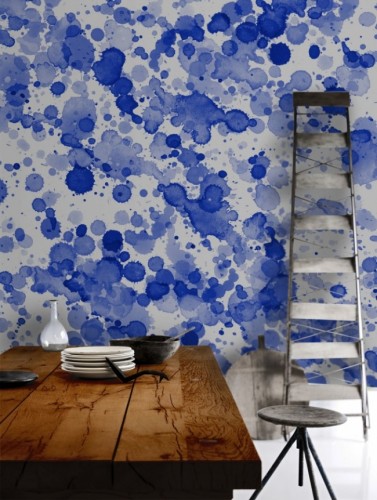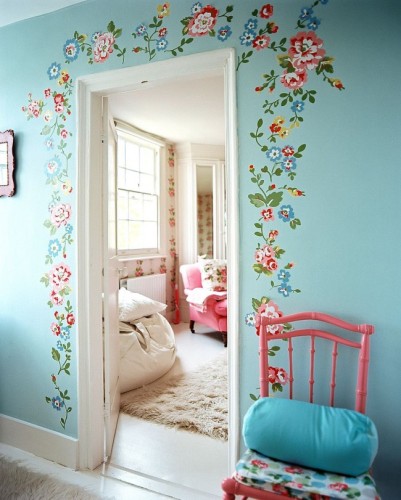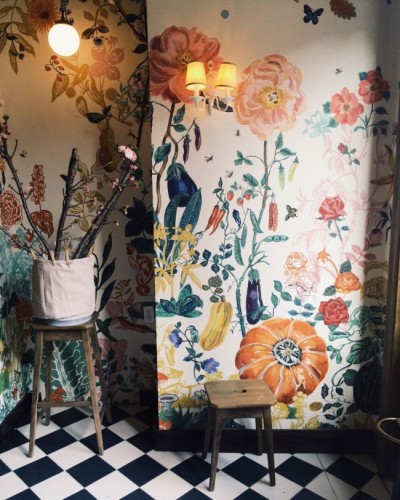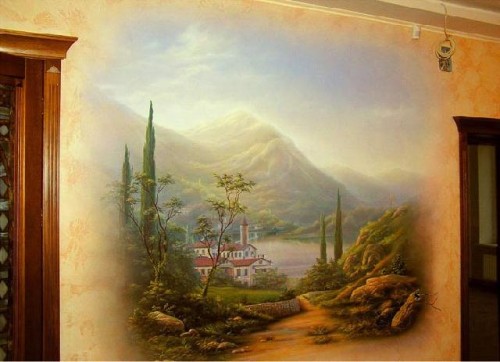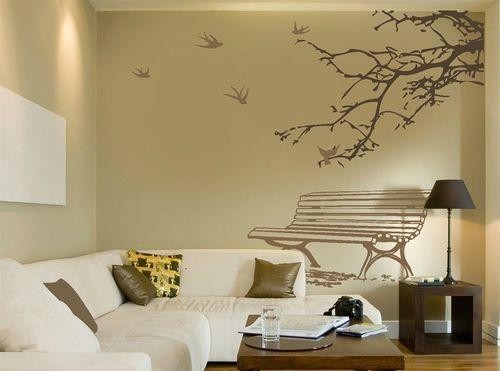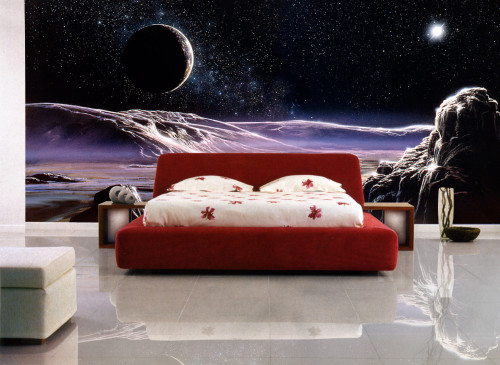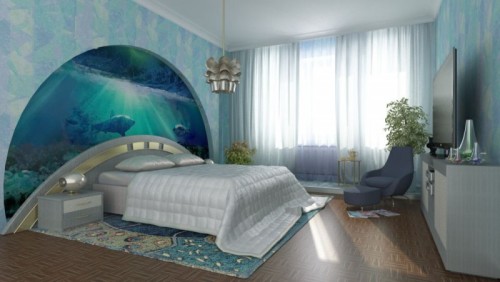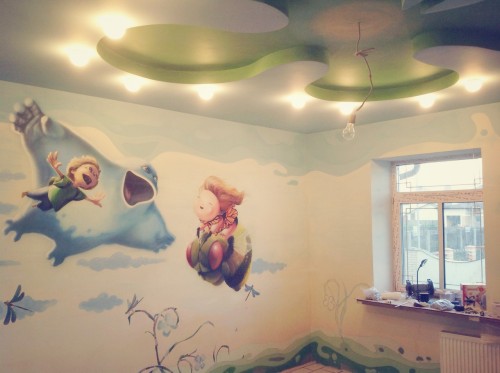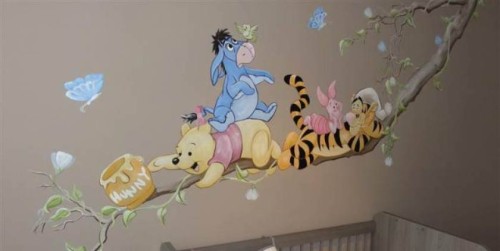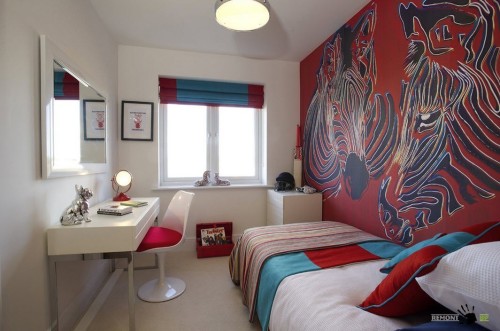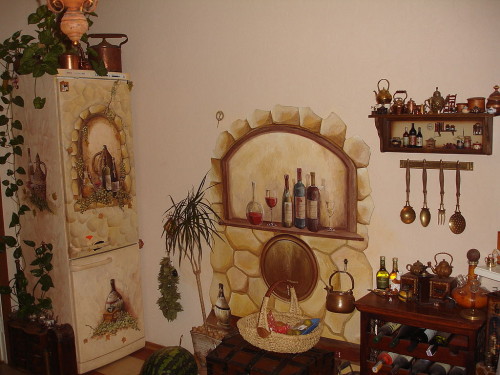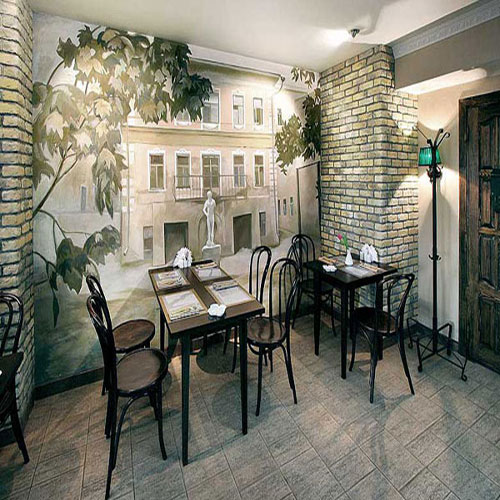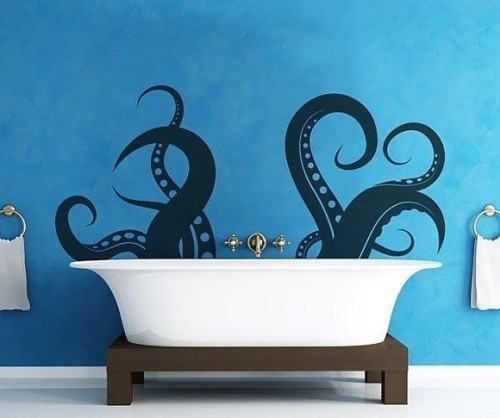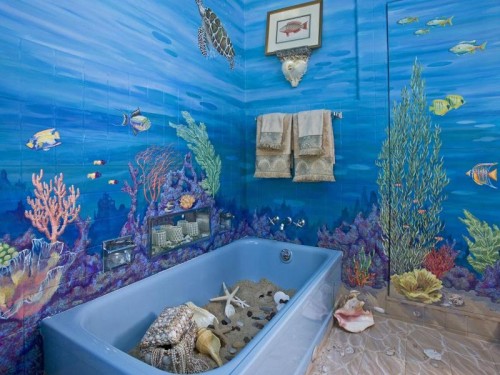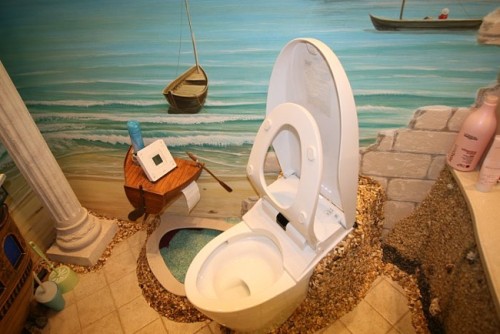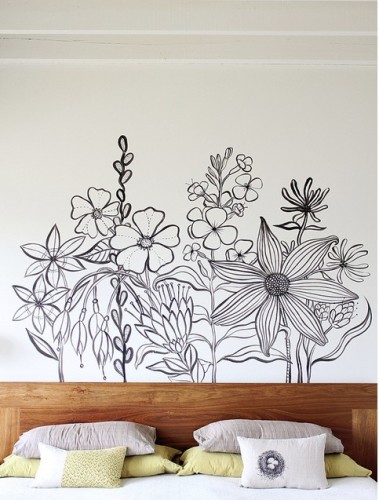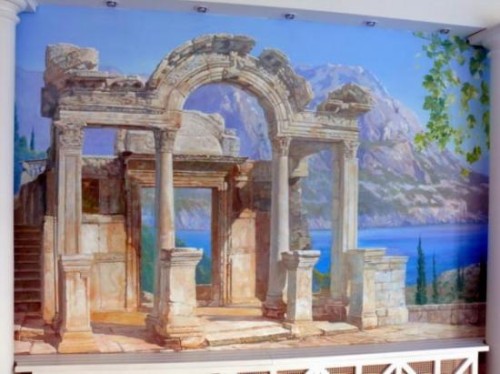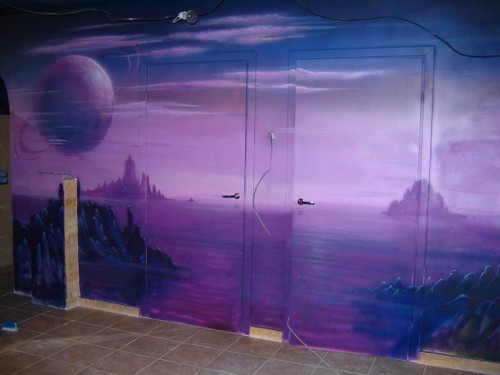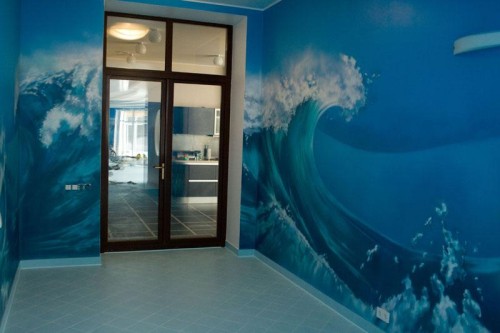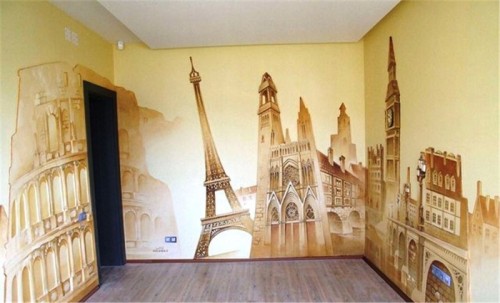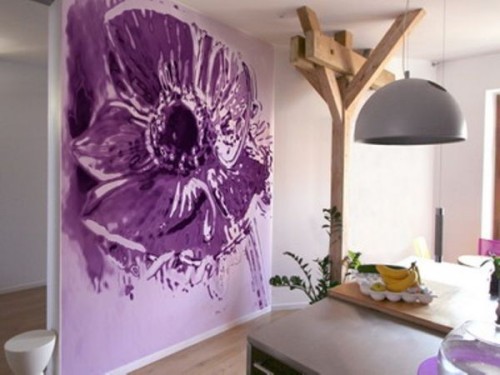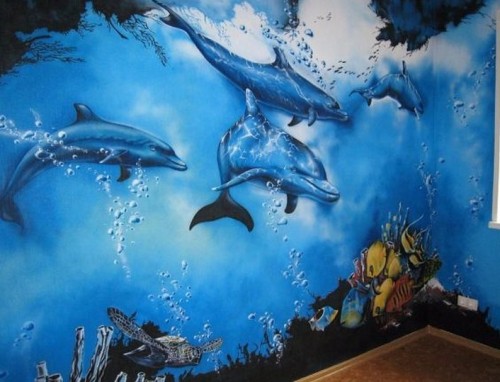Professional designers believe that wall painting is appropriate in any room, whether it be a small corridor, bedroom or bathroom. Moreover, this non -standard technique will allow you to transform and visually improve the decorated space. Even the most modest room with a typical layout can turn into original apartments using an image on the wall. As you have already guessed, in this article we will talk about the artistic painting of the walls in the interior and tell you how to apply the drawing so that it lasts many years.
Content
Features of wall paintings
Historically, a person began to live in limited walls and roof rooms. At first these were caves, then houses and apartments. And it is very important that this room is as comfortable and pleasant as possible for pastime, since most of the life flows in it. One way to create such comfort is to decorate the walls with painting. The walls occupy the largest area of \u200b\u200bhousing, and if they are gray, dirty and “boring”, no furniture and decor items will make such housing cozy.
There are incredibly many materials for the interior decoration of the walls, but painting was in demand in centuries and millennia ago. In ancient times, only rulers could afford the house, but now everyone can decorate the walls, especially since the cost of such a decoration is sometimes lower than alternative options. In fact, the artistic painting of walls and ceilings serves not only to create a general style, but is a self -sufficient design element.
Depending on the situation, painting can play an auxiliary or leading role. For example, if you have finished repairs in the room, but something is missing, you can use small images (flowers, patterns, geometric shapes, etc.) to complete the image. If we are talking about a large -scale image or decorating the entire area of \u200b\u200bthe walls and ceiling, then the painting will be leading, and all other methods of finishing and interior items should be selected, focusing on it.
There are several techniques of artistic painting walls:
- With brushes - the most ancient way that requires artistic skill, patience and special materials. To create paintings, special paints are used on an acrylic water -soluble basis. Previously, paints were made of natural materials: egg yolks, dull plants and minerals. Such pigments have been held for centuries, but the acrylic pattern, with the appropriate preparation of the surface, will delight the gaze for quite some time.
- Stencil is a modern technique for applying images. It will appeal to those who do not have artistic skills. To apply the picture, it is enough to attach a stencil (a sheet of paper with a cut pattern) to the wall and cover it with paint. The paint can be both can and aerosol. Using stencils, create simple monochrome images. At the end of the article you will find several examples of stencils for walls.
- Airbrushing - applying a picture using a special device spraying paint (airbrush). Such a technique allows you to create complex 3D drawings, but this requires professional skills and extensive experience.
- A relief drawing - artistic painting of walls in the relief is the most spectacular among the above techniques. The image is created from decorative plaster, giving it a special shape, after which the frozen surface is painted with paints with the help of brushes, rollers and stamps.

If you do not have artistic skills and traction to master them, hire a professional master for the painting of the walls. However, if you want to create a cozy home atmosphere with your own hands, some techniques can be used, even if you have never picked up paints.
Decorating walls with painting creates a composition that attracts attention, and is a decoration of any room. And although the cost of such work is quite high (if you order the master), it pays off by the fact that you get an exclusive interior design. There are no strict rules for placing painting on the walls. It should be understood that this is, first of all, an artistic technique, which means that free fantasy rules here.
There are no rules, but there are recommendations that will allow you to visually “replay” the space and present it in a more profitable light. So, in such small rooms as a bathroom, a toilet or a balcony, designers advise using drawings to change the geometry of the room, dialing the smallest end wall under the composition. There you can draw a landscape with a perspective or 3D image that visually expands the room. However, it should be borne in mind that the functionality of the room can suffer a little, because the wall with the pattern cannot be blocked.
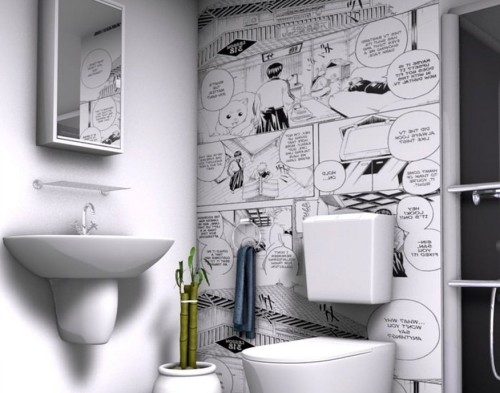
Choosing a drawing
You should choose an image for painting, guided by the general design of the room and its functional features. For example, in the bathroom, a drawing with bunnies drinking tea will be slightly inappropriate. However, there are universal topics suitable for any room: mountains, sea, dawn, all kinds of landscapes. They automatically add the prospect and visually increase the room. But only high -quality and realistic drawings are capable of this, which only professionals can fulfill.
Various flowers and any plant ornament can also be used in almost any room. They do not create prospects, but instantly create a feeling of lightness and comfort. And the most pleasant thing is that even a beginner can portray a beautiful flower using a stencil technique, for example.
Wall painting in different rooms
Despite the presence of universal topics, the walls of walls in various rooms should be approached with special care. It will be a shame if you spend your time and money on creating a drawing, but in a month you will understand that he is not to the place, or tired of being tired. When choosing an image, you should realize that you will have to look at it for years, so it is best to choose something as neutral as possible and what all family members will like. You should not use the same pattern for decorating walls in different rooms.
Wall painting in the corridor
The first thing that appears before the gaze entered into the house is the corridor. It is this straightforward and sometimes very tiny space that creates the first impression of the guests and sets the mood. The Soviet architects did not seem to know about this state of affairs at all, otherwise the corridors in the old houses would be a little more spacious and more convenient. Fortunately, this oversight can be corrected by an artistic painting of walls and other design techniques.
If we are talking about the corridor in a house or apartment, it is important to set the mood of comfort and care. For a small hallway, images on the walls in light colors are suitable - the lighter the room, the more spacious it seems. To visually make the ceiling above, use vertical lines or vertically located elements. If the corridor is slightly lit, choose the image in blue, light green or pink tones.
The dark background for the drawing is permissible only in the case of spacious halls, in which you can not only turn around, but also put furniture and other interior items. You rarely meet this in apartments. However, if you are lucky to have a large hallway, remember that its style design should still echo with the design of other rooms.
Wall painting in the living room
The living room is considered the central part of any house where all relatives and friends gather, leisure is held. A favorable and relaxed atmosphere should reign here, which is created not only by the mood of people, but also by the situation. The artistic painting of the walls in the living room can be represented by the most neutral drawings and themes. It should be understood that each family member has its own tastes, so everyone should like the image. Usually these are natural motives, Marina, sketches from everyday life, city landscapes or animal images.
Useful advice: To visually expand a small hallway, use images with the perspective, for example, a path running into the distance, a mountain landscape, sea surface, etc.
Images of columns, a dome vault on the ceiling, a fireplace with smoldering logs will look very beautiful in the living room.
Wall painting in the bedroom
In city apartments with a small number of rooms, every free centimeter would like to use with maximum benefit. Just imagine that in the bedroom a person spends a third of his whole life! And only in your power to make this stay easy and joyful. When designing a bedroom, you should not choose bright or too dark shades. The interior must calm, and not excite or press on the psyche, so give preferences with pastel and discreet tones.
The ideal motive for the sleeping mowl is the sky. It can be blue with light white clouds or night - with myriads of stars. Recently, “star” painting with ultraviolet and lighting colors has been gaining popularity. The former glow under ultraviolet lamps, the latter - on their own.
The bedrooms with a modest square can be visually increased using vertical motifs, light colors. Favorite designer technique for a visual increase in the height of the ceiling is to paint it white, capturing 15-20 cm of the upper part of the walls.
In one wall painting, one can and should be combined at once several images. For example, you can draw a sunny morning and a blue sky with multi -colored acrylic paints, and on top of them to create a starry sky invisible in the daylight of pigments. They will become noticeable only with the onset of night.
Wall painting in children's
The art painting of the walls of the children's room requires special attention. The choice of image here should be approached, starting from the age of the child and his personal preferences. For children under 3 years of age, there is no need to draw complex multi-colored motifs, since it will not only not be able to evaluate your efforts, but will experience discomfort due to an excess of complex images and shades.
For older children aged 3 to 7 years, you can already choose more complex and colorful drawings: heroes of your favorite cartoons, characters of fairy tales, cars, superheroes from comics, etc. It is important to consider not only the semantic filling of the picture, but also the color content. So, if you paint the boy’s room in red tones, depicting a racing highway with pain on the wall, do not be surprised that the baby will grow by fidget and clogging. The psyche simply will not be able to relax in such a rich environment. The yellow color (contributes to mental development), green shades (relax and pacify), a little blue and blue will develop creative potential, white color will reduce the stiffness and clamping in communication.
The third age period is from 7 to 17 years, when the child radically changes his preferences in everything. Get ready for the fact that recently adored cartoons on the walls will have to be painted with plain motifs. Do not forbid your child to express himself in this way, but keep the situation within a reasonable framework. For example, if a teenager wants to paint the walls in a dark-graphite or bright purple color, find a compromise in the use of this color only partially-as chaotic geometric figures on a light background or painting only one wall.
Wall painting in the kitchen
The kitchens in the apartments are usually small and almost completely forced by furniture, which is why some discomfort is created. Only a pattern on the wall can not be dispensed with, but it can act as an auxiliary measure for visual expansion of space. All the same landscapes with perspective, 3D -style drawings, as well as color zoning are appropriate here.
Under the image in the kitchen, designers recommend that the part of the wall, near which there will be a table. If the table is at the window, you can apply the image to the apron above the working area. And in order for the picture to be more voluminous and holistic, it is framed by polyurethane moldings, decorative plaster or artificial stone.
Wall painting in the bathroom
The bathroom is a rather specific room where the level of humidity and temperature constantly changes. It is not so much important to decide on the theme of the image, how to choose the right colors for the artistic painting of the walls. They should withstand temperature and humid changes, be resistant to minor mechanical influences, not lose color and be absolutely environmentally friendly.
Since most bathrooms in apartments cannot boast of spaciousness, it is recommended to use the already described design techniques for visual expansion of space. Underwater landscapes with depicted marine residents look very beautiful on the walls in the bathroom: dolphins, coral reefs, etc.
Useful advice: you can decorate not only the walls, but also order the application of the image to the bath itself.
To enhance the effect, use backlight. For the bathroom, as for any other room, a traditional lamp on the ceiling is completely not enough, so do not hesitate to install multi -level lighting. But do not forget about the specific “climate” in this room - in the bathroom it is best to use LED ribbons and LEDs (they withstand high humidity and work under low voltage).
Features of painting
In this chapter, we will tell you how to apply the image on the wall with our own hands. The most important thing in this task is not so much in choosing a motive and paint as in a thorough preliminary preparation of the wall. If the image is applied to the unprocessed base, it will not last long.
If you do not have professional artistic skills, you should choose a drawing based on your skills. It is best for beginners to limit yourself to stencil technology, but even with its help you can create a stylish interior. The painting of the walls with artistic plaster is quite complicated, so it is best to start with simpler techniques, for example, drawing with a brush. The drawing should also be as simple as possible so that you can transfer it to the wall, observing all the proportions. Flower motifs, architectural compositions, and silhouettes of animals are very convenient in this regard.
Useful advice: to transfer the image to the wall, use a large -scale grid technique or use the projector.
Medical application technology:
- Prepare the surface - the wall must be leveled as much as possible. The painting is able to “look away” from some defects such as minor differences in height, but the surface itself should be smooth so that the paint holds well. If there is an old finish on the walls, remove it, cleaning it to the plaster.
- Comers the wall with two layers of putty, if necessary. Apply the second layer only after the previous one dries completely. If the leveling of the wall requires the application of the putty layer with a thickness of more than 2 mm, it is necessary to lay the reinforcing mesh for strength.
- After the putty dries, cover the wall with soil. A primer is a special composition that increases the adhesion of paint with the base. The primer also closes numerous pores in the primer through which moisture from paint can absorb too quickly (leads to excessive paint consumption).
- After drying the soil, heal the background of the future image and transfer the pattern to the wall with a simple pencil (large -scale mesh or projector). In the process of transferring the image to any of the methods from time to time, go a certain distance to control the fidelity of the scale and proportions of the drawing (near the distortions are invisible).
- It remains only to paint the image in accordance with the sketch.
Acrylic and latex paints are not washed off, but for greater strength, the image can be covered with transparent varnish.
If you like volumetric artistic painting of walls, only a professional will cope with such a job. As an alternative, you can use 3D wallpaper or murals, but it will no longer be painted.
Caring for a painted wall implies periodic wiping with a damp soft rag. If this is an embossed painting, it is necessary to brush off dust from protrusions from time to time.
